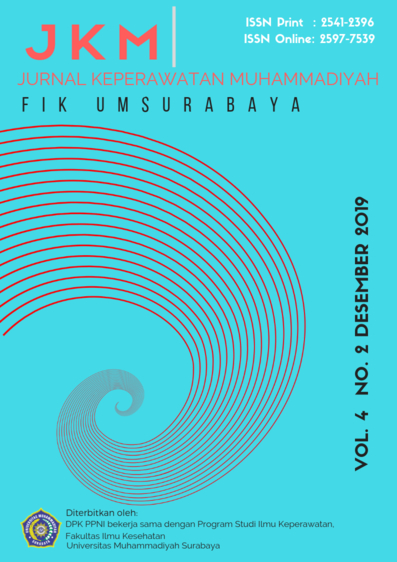Intervensi Untuk Meningkatan Status Nutrisi Pasien Hemodialisa : Systematic Review
DOI:
https://doi.org/10.30651/jkm.v4i2.3076Keywords:
Hemodialisa, Intervensi Keperawatan, Status NutrisiAbstract
Hemodialysis is a therapy in patients with kidney failure associated with inflammatory processes and malnutrition. This systematic review aims to identify and assess the effectiveness of nursing interventions that have an impact on the nutritional status of patients with hemodialysis. A systematic search was carried out in several international data bases, namely: PuBMED, ProQUEST, and Science Direct. We included 9 studies related to intervention to improve the nutritional status of hemodialysis patients who have been tested for quality with CASP and JBI. There are 3 studies evaluating educational and information interventions, 3 studies evaluating enriched food supplementation, 2 studies evaluating dietary interventions, and 1 studi evaluating physical exercise interventions. The studi included significant results on positive changes in the nutritional status of hemodialysis patients, ie there was an increase in food intake, nutritional laboratory markers, anthropometrics and there was a decrease in serum trigleserid levels, IDGW lines and dry weight, and no PEM condition was found after the intervention was given in time certain. The choice of education and information interventions, the provision of enriched food supplements, diet and physical exercise can provide a good effect on improving the nutritional status of patients with hemodialysis, but resources and cost effectiveness need to be taken into consideration.
References
CASP. (2017). Critical Appraisal Skills Programme (Randomised Controlled Trial). Critical Appraisal Skills Programme, 317(2017), 1–5. Retrieved from http://docs.wixstatic.com/ugd/dded87_4239299b39f647ca9961f30510f52920.pdf%0Ahttp://media.wix.com/ugd/dded87_4239299b39f647ca9961f30510f52920.pdf
Chen, J., Peng, H., Xiao, L., Zhang, K., Yuan, Z., Chen, J., … Huang, H. (2013). The Insufience Intake of Dietary Micronutrients Associated With Malnutritio-Inlfammmation Score In Hemodialysis Population. PLoS ONE, 8(12), 4–9. https://doi.org/10.1371/journal.pone.0083233
Cohen, J. F., Korevaar, D. A., Altman, D. G., Bruns, D. E., Gatsonis, C. A., Hooft, L., … Bossuyt, P. M. M. (2016). STARD 2015 guidelines for reporting diagnostic accuracy studies: Explanation and elaboration. BMJ Open, 6(11), 1–17. https://doi.org/10.1136/bmjopen-2016-012799
Colson, Arthur., Brinkley, Anita., Braconier,Philipe., Ammor, Nadia., Burnier, Michel., Pruijm, Menno. (2016). Impact of reducing salt content of meals consumed during hemodialysis sessions on hemodynamic stability and interdialytic weight gain. Nephrology Dialysis Transplantation, 31, 1–6. https://doi.org/http://dx.doi.org/10.1093/ndt/gfw198.58
Ebrahimzadehkor, B., Dorri, A., Yapan-gharavi, A., Deputy, T., & Sciences, M. (2012). Zahedan Journal of Research in Medical Sciences, 25–28.
Ghalia Elmoghazy, Salwa Abbas, Amany Sobhy, and A. F. (2016). Nursing intervention for enhancing hemodialisys patient adherence to teraupetik regimen, 12(11), 84–93. https://doi.org/10.7537/marsjas121116.08.Key
Gonzalez-Ortiz, A. J., Arce-Santander, C. V., Vega-Vega, O., Correa-Rotter, R., & Espinosa-Cuevas, M. D. L. A. (2014). Assessment of the reliability and consistency of the “malnutrition inflammation score†(MIS) in Mexican adults with chronic kidney disease for diagnosis of protein-energy wasting syndrome (PEW). Nutricion Hospitalaria, 31(3), 1352–1358. https://doi.org/10.3305/nh.2015.31.3.8173
Ho, L. C., Wang, H. H., Peng, Y. Sen, Chiang, C. K., Huang, J. W., Hung, K. Y., … Wu, K. D. (2008). Clinical utility of malnutrition-inflammation score in maintenance hemodialysis patients: Focus on identifying the best cut-off point. American Journal of Nephrology, 28(5), 840–846. https://doi.org/10.1159/000137684
Jo, I.-Y., Kim, W. J., Park, H. C., Choi, H. Y., Lee, J. E., & Lee, S. M. (2017). Effect of Personalized Nutritional Counseling on the Nutritional Status of Hemodialysis Patients. Clinical Nutrition Research, 6(4), 285–295. https://doi.org/https://dx.doi.org/10.7762/cnr.2017.6.4.285
Karavetian, M., Elzein, H., Rizk, R., Jibai, R., & de Vries, N. (2016). Nutritional education for management of osteodystrophy: Impact on serum phosphorus, quality of life, and malnutrition. Hemodialysis International, 20(3), 432–440. https://doi.org/10.1111/hdi.12405
Lai, A. Y., Ishikawa, H., Kiuchi, T., Mooppil, N., & Griva, K. (2013). Communicative and critical health literacy, and self-management behaviors in end-stage renal disease patients with diabetes on hemodialysis. Patient Education and Counseling, 91(2), 221–227. https://doi.org/10.1016/j.pec.2012.12.018
Lai, S., Molfino, A., Coppola, B., De Leo, S., Tommasi, V., Galani, A., … Muscaritoli, M. (2015). Effect of personalized dietary intervention on nutritional, metabolic and vascular indices in patients with chronic kidney disease. Eur Rev Med Pharmacol Sci, 19(18), 3351–3359. https://doi.org/10.2147/IJNRD.S90791.
Ma, L. C., Chang, H. J., Liu, Y. M., Hsieh, H. L., Lo, L., Lin, M. Y., & Lu, K. C. (2013). The relationship between health-promoting behaviors and resilience in patients with chronic kidney disease. The Scientific World Journal, 2013. https://doi.org/10.1155/2013/124973
Magnard, J., Deschamps, T., Cornu, C., Paris, A., & Hristea, D. (2013). Effects of a six-month intradialytic physical ACTIvity program and adequate NUTritional support on protein-energy wasting, physical functioning and quality of life in chronic hemodialysis patients: ACTINUT study protocol for a randomised controlled trial. BMC Nephrology, 14(1). https://doi.org/10.1186/1471-2369-14-259
Mat Daud, Z. ’Azuan, & Khosla, P. (2014). Multifaceted nutritional intervention in hemodialysis patients.
Moher, D., Liberati, A., Tetzlaff, J., Altman, D. G., Altman, D., Antes, G., … Tugwell, P. (2009). Preferred reporting items for systematic reviews and meta-analyses: The PRISMA statement. PLoS Medicine, 6(7). https://doi.org/10.1371/journal.pmed.1000097
Molnar, M. Z., Carrero, J. J., Mucsi, I., Remport, A., Rhee, C. M., Kalantar-Zadeh, K., … Cordeiro, A. C. (2015). Comparison of the malnutrition–inflammation score in chronic kidney disease patients and kidney transplant recipients. International Urology and Nephrology, 47(6), 1025–1033. https://doi.org/10.1007/s11255-015-0984-2
NHANES. (2016). National Health and Nutrition Examination Survey.
Ocepek, A., Bevc, S., & Ekart, R. (2017). Impact of short-term nutritional supplementation on surrogate markers of undernutrition in hemodialysis patients – prospective real-life interventional study. Clinical Nephrology, 88(S1), 65–68. https://doi.org/10.5414/CNP88FX16
PERNEFRI. (2016). Perhimpunan Nefrologi Indonesia 8Th Anual Report Of Indonesian Renal Registry.
Ristic-Medic, D., Perunicic-Pekovic, G., Rasic-Milutinovic, Z., Takic, M., Popovic, T., Arsic, A., & Glibetic, M. (2014). Effects of dietary milled seed mixture on fatty acid status and inflammatory markers in patients on hemodialysis. The Scientific World Journal, 2014. https://doi.org/10.1155/2014/563576
Sezer, S., Bal, Z., Tutal, E., Uyar, M. E., & Acar, N. O. (2014). Long-term oral nutrition supplementation improves outcomes in malnourished patients with chronic kidney disease on hemodialysis. Journal of Parenteral and Enteral Nutrition, 38(8), 960–965. https://doi.org/10.1177/0148607113517266
The Joanna Briggs Institute. (2017). JBI_Quasi-Experimental_Appraisal_Tool2017.
Downloads
Published
Issue
Section
License
- Penulis tetap memegang hak atas karyanya dan memberikan hak publikasi pertama kepada jurnal ini yang secara simultan karya tersebut dilisensikan di bawah:Â Creative Commons Attribution-ShareAlike 4.0 International (CC BY-SA 4.0)













